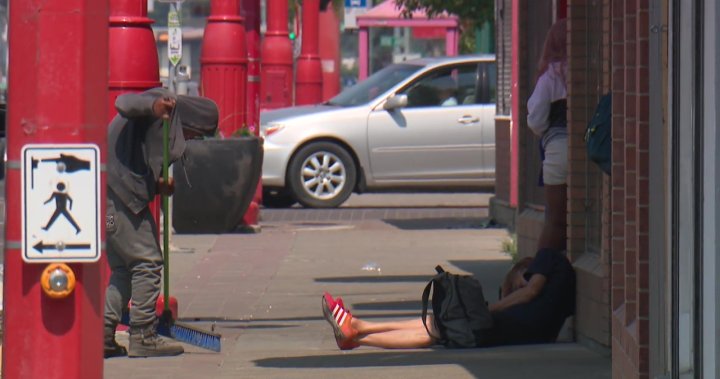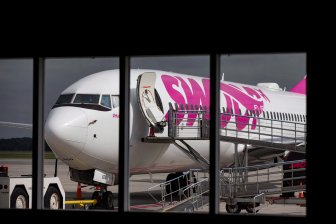
This is the second article in a three-part series examining Edmonton’s core one year after the city introduced a “safety plan” after two men were killed in Chinatown. The first article on addressing crime can be read here and the next article on revitalizing the neighbourhood can be read Sunday.
While a multitude of resources have gone towards “boots on the ground” in an effort to address crime and homelessness in Edmonton’s core, many resources are also going to prevention, in the form of addiction and mental health treatment, affordable housing and other social supports.
Though homelessness is often seen as going hand in hand with crime and disorder, advocates and city representatives have been careful to underline that there is not a link between the two phenomena.
However, University of Alberta criminologist Temitope Oriola said poverty, homelessness, adverse childhood experiences, drug addiction and mental health problems are the root causes of many crimes.
“None of those social issues can be separated from issues in relation to this organized crime downtown and elsewhere around Edmonton, or any city for that matter,” he said.
Reports from city staff acknowledge that “some disorder observed is rooted in core social issues such as lack of housing, mental health and substance use.”
Regardless of whether homelessness, crime and disorder are linked, police are on the front lines responding, and Oriola suggested a more multi-pronged approach could be more effective.
“The solution to open drug use and homelessness is not more police, it is providing shelters, it is providing safe injection sites and all of that,” he said, adding he thinks more police is an interim solution.
“We’ve got to do more in terms of the social issues at the root of those problems — mental health support for our citizens, shelter for the homeless, supports for those who are drug addicted.”
In the second of a three-part series, Global News is looking at what has been done to address what some call the root causes of crime and disorder and talking to community members to see if they think the situation is improving.
Addiction, mental health support
Shortly after the killings in Chinatown, the city, Downtown Business Association and Boyle Street Community Services (BSCS) announced they would pilot a new program called Overdose Prevention and Response Teams (OPRTs) to help prevent and respond to drug poisonings in Edmonton, funded with a $195,000 Downtown Vibrancy grant.
On Dec. 13, 2022, the provincial government announced the launch of the Edmonton Public Safety and Community Response Task Force to address addiction and homelessness in the city. The government said more than $60 million went to increasing access to addiction services.
“Alberta spends more than $1 billion annually on addiction and mental health care and supports, including prevention, intervention, treatment and recovery,” the province said in a news release.
Since being elected in 2019, the UCP government says it has added 147 annual treatment beds in Edmonton, eliminated daily user fees at treatment spaces, introduced a digital overdose prevention tool, and is expanding access to addiction treatment medication.
A new addiction recovery centre will be built in Enoch Cree Nation, just outside Edmonton, that will provide “holistic addiction treatment services” for up to 300 people a year, the province announced in April.
The province said partnering with Indigenous communities is important because they are some of the most affected by the addiction crisis. The provincial government is chipping in $30 million to fund the project.
Some harm-reduction advocates have criticized the province’s recovery-oriented system of care, particularly a bill promised by Premier Danielle Smith during her election campaign that would “allow a family member, doctor or police officer to make a petition to family court for a treatment order when someone is a danger to themselves or others.”

When people spend time in involuntary treatment, it reduces their tolerance, and if they relapse, they’re far more likely to have an overdose, according to Elaine Hyshka, an associate professor at the University of Alberta’s School of Public Health.
Smith’s chief of staff said the treatment would be voluntary and there would be no penalties for refusing drug treatment.

Opioid overdose deaths in Edmonton are down, according to Alberta Health Services.
In January 2023 – the most recent month for which data is available – 29 people died of an overdose in the city.
That’s down from a peak of 70 people in the month of December 2021 and almost as low as the number of deaths in April 2020 before fatalities started to skyrocket during the pandemic.
AHS said hospitalizations and emergency department visits related to opioids are also down when comparing 2022 to 2021.
Chinatown business owner Will Chen said he sees a lot of people struggling with mental health issues in the neighbourhood and he believes that should be addressed first.
“While, yes, housing would help, I think primarily mental health support is what these people seek the most,” he said.
Homelessness
As part of the safety task force, the province also introduced $19 million in funding to combat homelessness.
Global News asked the province for more details on what that money is going towards but did not receive an answer in time for publication.
The province also introduced a 10-year strategy in 2021 that it hopes will improve and expand affordable housing into the future.
The strategy says the province aims to add 13,000 new units and support 25,000 more households in the plan. It also aims to provide rent assistance to 12,000 more households.
The province allocated almost $1 million for renovations to a handful of affordable housing providers in Edmonton in its latest budget, as well as about $14 million to build new units over the last two budgets.
The City of Edmonton has numerous ongoing programs and partnerships that aim to address and prevent homelessness.
In the 2023-26 budget, city council approved nearly $50 million that will go to the affordable housing and homelessness department. That money will be used as grants for housing providers.
On top of that, the city hopes to squeeze out even more money in the budget for affordable housing through the city’s OP12 process.
The city provided $7.5 million in emergency funding for a shelter in the west end in November after multiple people died in homeless encampments.
City council is also looking to change the way the city responds to homeless encampments, changing the focus from removing the camps to keeping them as safe as possible while connecting the residents with housing support.
Christel Kjenner, the city’s director of affordable housing and homelessness, said increasing the supply of affordable housing is one of the most important ways to keep people from falling into homelessness.
“It helps people who have low incomes — and very low incomes — access housing that’s affordable to their income so that they can stay housed,” she said.
Edmonton has 14,000 units of affordable housing but needs 60,000 more, Kjenner said.
She added it’s not just about affordability — supportive housing is important to keep people housed.
“If there’s health issues or mental health issues involved too, then having access to those supports is really critical for well-being,” Kjenner said.
But despite all these efforts, more people are becoming homeless than are getting into a stable place to live. In 2022, an average of 462 people became homeless every month, and more than half were becoming homeless for the first time, according to Homeward Trust.
In fact, there are now more homeless people in Edmonton than ever before. As of June 5, there were 3,112 homeless people in Edmonton, higher than the previous peak of 3,079 in 2008 and double the amount in 2019, according to Homeward Trust’s by name list.
Kjenner said it’s hoped by the end of 2023 the city’s new Community Plan to End Homelessness will be put together, along with a plan for homelessness prevention.
BSCS provides support for vulnerable people from a location near Rogers Place, and plans to open another location nearby as well as one in south Edmonton.

Spokesperson Elliot Tanti said he believes there just isn’t enough space for vulnerable people to go.
“The enforcement approach around encampments is really just moving people around,” he said.
“We need to be thinking about well-rounded approaches, increased social services, increased housing.”
Mayor Amarjeet Sohi said the city lacks the capacity to address root causes.
“The fundamental issue of not having access to housing, not having access to treatment for mental health and addictions that are causing a lot of these issues, and that’s where the role of the provincial government comes,” he said.
However, Sohi also acknowledged the province has supported the city in building more affordable housing units.
“I hope that the new government under Premier Danielle Smith will hopefully reset their approach to how they look at these very complex and complicated issues that people are facing.”
















